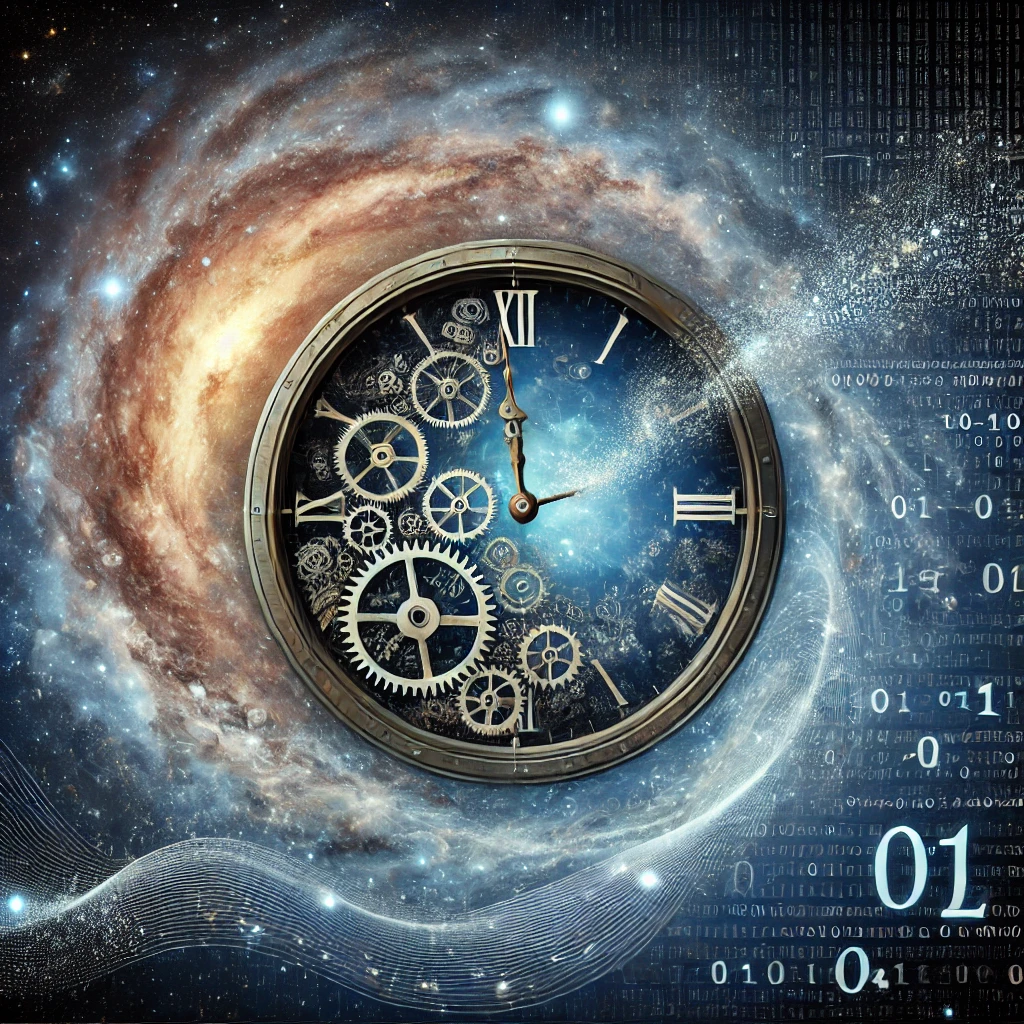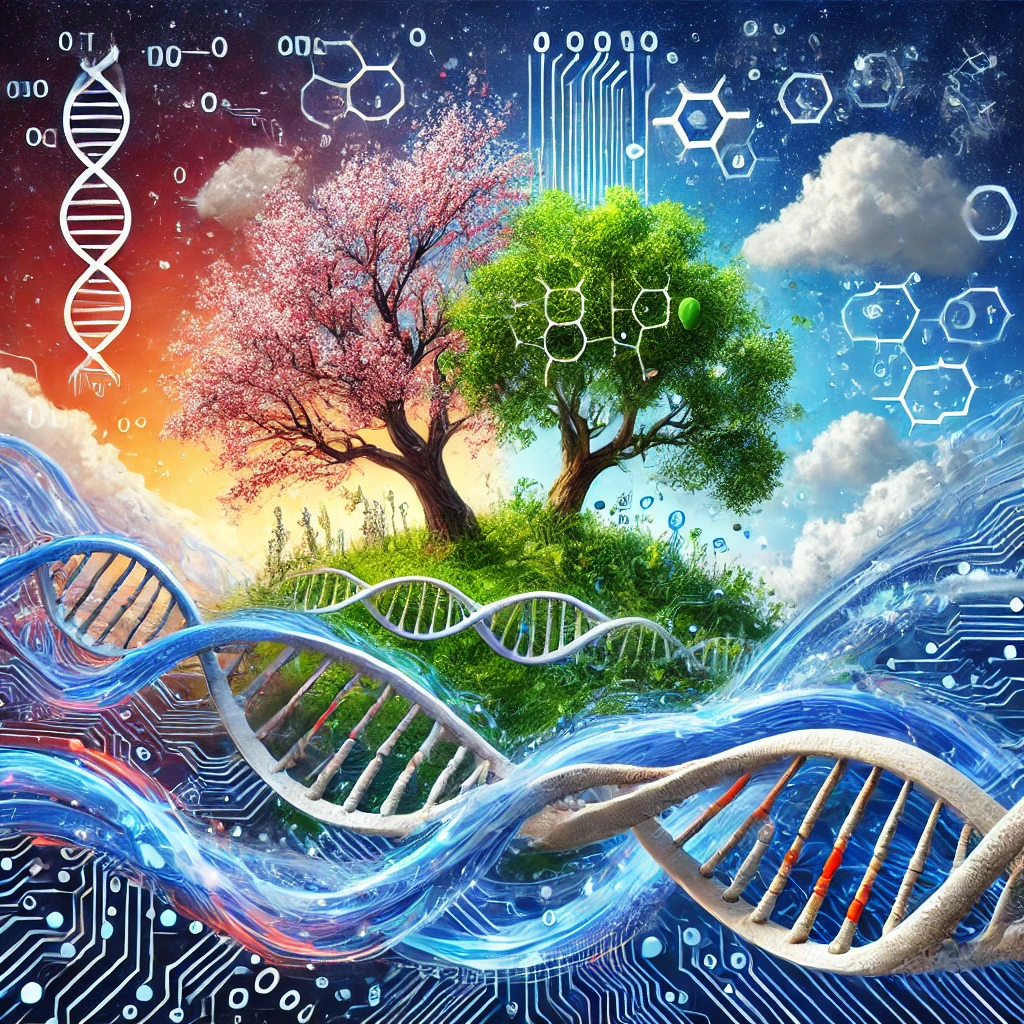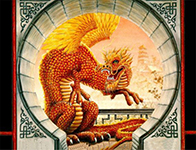- Infogenesis (Part 11) – Information: It’s Not What You Think!
- Infogenesis (Part 10) – A Letter to Professor Michael Levin
- Infogenesis (Part 9) – What is Information?
- Infogenesis (Part 8): The Birth of Meaning
- Infogenesis (Part 7): Rethinking Reality
- Infogensis (Part 6): Why Information is a Fundamental Property of the Universe
- Infogenesis (Part 5): The Fundamental Role of Information
- Infogenesis (Part 4): Exploring Information as a Fundamental Property of the Universe
- Infogenesis (Part 3): Can Information Exist Without a Mind?
- Infogenesis (Part 2): Claude Shannon – The Father of the Information Age
- Infogenesis (Part 1): Introduction
If you’re anything like me, you have probably watched your share of television science programs like Nova on PBS. Because of this exposure, if you saw a scientist being asked what the universe was made of, you wouldn’t be surprised to hear the reply: “That’s simple, matter and energy!” Even if you’re not a scientist, these two terms should be familiar enough, but let’s review them here so we’re all on the same page.
Matter is the “stuff” we can see and touch—everything from people to planets. On the other hand, energy makes things happen, like sunlight warming your face or a car engine turning gasoline into motion. Matter and energy are the two fundamental components that make up our reality—at least, that’s what we’ve been taught.
In Part IV of this series, I introduced you to an idea proposed by scientist and philosopher, Tom Stonier (sadly, now deceased). Stonier argued that there’s a third fundamental component in the mix—one we tend to overlook because we think of it as purely human-made. This component is information. And I’m not just talking about what we find in emails or computer files! According to Stonier, information is an underlying critical component of the universe, one that helps shape everything around us.
Now, in Part V, I want you to join me as I explore how information does not just exist passively, but instead how it acts as a blueprint that enables matter and energy to organize, thus allowing complexity to emerge and be reflected in everything we see, from living organisms to galaxies.[i]
Defining Information
Before going too far into this subject, I think this is a good place to try and answer the questions that you’re probably asking yourself at this point: “What the hell is Jeff talking about?” “What does he mean that information helps shape the universe?” “How the hell does that work?” Believe me, I’ve almost scratched a bald spot on my head trying to answer these same questions! The effort has led to reading many books, watching numerous Youtube videos, and having numerous long conversations with several eternally patient and non-judgmental AI tutors. So, let me make an effort to share what I’ve learned.

First, when scientists use the word “information,” especially in physics, they are not talking about the information you and I know and love i.e., they don’t mean information like you’d find in a book, a computer file, or a database. Rather, they are using information in a way that is quite different from what we are used to, because they are looking at information as the underlying logic, or pattern, that governs how matter and energy behave.
Let’s take an example, say, the information for how a star is born, evolves, and dies. Does this particular information really exist? Sure it does! After all, stars are born, evolve and die all the time in the universe. Somehow, matter and energy manage to work together to pull off this amazing feat repeatedly. This is because there is something that provides matter and energy the – wait for it – information required that allows them to do so! And in this case, the information that tells them how to do this is something you’ve no doubt heard of previously, usually referred to as “the laws of physics.”
Wait, what? So, the information I’m talking about is the same as the laws of physics? Why not just run with the laws of physics instead of rebranding them as information? What’s to be gained by calling them information?
Good questions. I’m glad you asked.
Well, for one thing, calling the laws of physics information allows us to broaden our perspective beyond just describing physical processes. Sure, the laws of physics tell us what matter will do under certain conditions, but referring to them as information implies that these laws are a part of something more, that they don’t just describe, but enable and guide the behavior of the universe, providing the blueprint that matter and energy follow.
In other words, information is more than a static set of rules or a passive record. Information is the functional content that enables matter and energy to assemble into more and more complex systems. When we frame the universe as an information-driven system, it opens up new ways of thinking about phenomena like life and intelligence. This perspective invites questions about whether non-physical systems, like biological processes or even artificial intelligence, might be driven by this same organizing principle.
Allow me to belabor this point by explaining the same thing in different ways, because it’s complicated and I think it’s important for understanding what is coming later.

Most people think of information as facts, numbers, or words on a page. But in Stonier’s theory, information is much more than just data. It’s the thing that allows the universe to be organized, much like how a set of instructions organizes materials to build a house or how a recipe organizes ingredients to create a dish. In other words, it’s the thing that enables order to emerge out of chaos, giving shape and structure to the world around us.
Think about how a blueprint organizes the construction of a house. Without it, you’d just have a bunch of bricks, wood, and metal lying around. It’s the “blueprint”—the information—that tells the builders how to turn those raw materials into a house. In the same way, information in the universe acts like a blueprint for organizing everything from the smallest atoms to the largest galaxies. Without information, the raw materials of the universe—matter and energy—would remain chaotic, with no structure or organization. It is information, acting through physical laws, that allows the universe to evolve into its current state of complexity.
Another example we’re all familiar with is DNA. One might be tempted to say that DNA contains the instructions for how to build and maintain a living organism, but technically, if you want to be correct, DNA does not contain the instructions for life. Nope! DNA IS the instructions for life! With a nod to Marshal McLuhan, when it comes to DNA, the medium IS the message! Similar to the discussion above about the birth, evolution and death of a star, the information as to how to do this is not contained in the laws of physics. The laws of physics IS the information telling matter and energy how to behave for stars. It’s information in action, if you will i.e., that string of genetic code that tells cells how to grow, replicate, and function. Without the information encoded in DNA, there’s no organization, no life, just a bunch of chemicals sitting around doing nothing.
DNA is a useful example that helps support another idea of Stonier’s: that information does not depend on humans and in fact, precedes us. Precedes us? Think about it. DNA, after all, has been around for at least a billion years, far longer than we humans have been on the scene.
Is this starting to make a little bit of sense? Hang in there.
Challenging the Traditional View of Information
For a long time, scientists and philosophers viewed information as something purely human-made—something communicated, recorded, or stored for the purpose of exchanging ideas or data. In this view, information was a tool, created and used by humans, existing only as long as we had something to say. But Stonier flips this idea on its head. He argues that information is just as fundamental to the universe as matter and energy. In fact, information has been present since the very beginning, shaping reality long before humans came on the scene.

We tend to think of information as something we create – emails, books, or computer programs are the typical examples. But what Stonier proposes is that information is woven into the very fabric of the universe itself. In other words, the universe doesn’t just follow the laws of physics—it is structured by them, with information guiding how matter and energy interact at every level. This means that information didn’t arise with human language or thought—it has been an integral part of the cosmos from the very beginning.
Energy, Matter, and Information: A Cosmic Triad:
Stonier suggests that the universe operates as a kind of universal three-legged stool, with energy, matter, and information all playing equally important roles. Here’s a way to think about it:
- Matter is the substance, the “stuff” of the universe.
- Energy drives change, making things move, grow, or interact.
- Information describes the structure that matter and energy follow, it encodes the rules that guide their interactions.
Let’s take an everyday example of a plant growing. Energy from the sun fuels the growth process (photosynthesis), and matter (carbon dioxide, water, etc.) provides the raw materials. But the plant grows in a structured way because the information in its DNA tells it how to convert that energy and matter into specific cells, leaves, and roots. In the same way, stars, planets, and galaxies are organized and structured by information acting on matter and energy.
Revisiting Scientific Models:
For centuries, scientists have built our understanding of the universe around two fundamental components: matter and energy. These elements sit at the heart of countless scientific models, from Newton’s laws of motion to Einstein’s theory of relativity. But Stonier’s work challenges us to rethink this approach. He suggests that we can no longer view the universe solely in terms of matter and energy—we must also account for information as a third, equally fundamental component.

Stonier’s idea might seem radical, but it’s worth considering what it means for how we understand the universe. If information is as fundamental as matter and energy, it changes the way we interpret everything, from the formation of galaxies to the development of life on Earth. We’ve long accepted that matter and energy interact according to predictable laws, but what if those laws themselves are encoded in the fabric of the universe as information?
Take, for example, the laws of thermodynamics. These laws describe how energy is transferred and transformed, often leading to an increase in entropy—essentially, disorder. But Stonier’s work suggests that information might act as a kind of counterbalance to entropy, creating and maintaining order. While energy naturally disperses over time, information could be the organizing force that pushes back, preserving structure and enabling complexity to arise.
The Implications of Information as Fundamental:
What happens when we start thinking of information as a fundamental property of the universe? For one thing, it forces us to reconsider some long-held assumptions about how reality works. For example, physicists have long grappled with the question of whether the universe is ultimately deterministic or random. (Note that the majority of scientists today look at the universe as deterministic). But if information is fundamental, it supports the idea there is an inherent order or pattern that guides the universe’s evolution.
This perspective has profound implications across a range of fields. In cosmology, it could mean that the structure of the universe—from galaxies to black holes—is governed not just by gravity and energy but also by information encoded in the laws of physics. In biology, it could mean that life itself is an expression of information interacting with matter and energy, with DNA acting as the code that organizes living systems. And in artificial intelligence, it opens up the possibility that intelligence may emerge from the way information is organized and processed within a system, much like how the brain processes information.
In short, recognizing information as fundamental doesn’t just change how we see the universe – it could also change how we approach science itself. If information is as foundational as matter and energy, we might need to rethink the very models we use to describe reality.
The Role of Information in Entropy:
One of the most intriguing aspects of Stonier’s work is how he links information to entropy. Traditionally, entropy is understood as a measure of disorder in a system. In thermodynamics, systems naturally move from a state of order to disorder over time, as energy dissipates and spreads out. But here’s where information comes into play.

Stonier suggests that information can act as a counterbalance to entropy. While energy tends to increase entropy, pushing systems toward chaos, information helps preserve order. It defines the structure and organization of a system, ensuring that complexity can arise and be maintained, even in the face of entropic forces.
Think about a house. Over time, without maintenance, the house will naturally fall into disrepair—that’s entropy at work. However, the blueprint for the house – the information that guides its construction – remains intact. As long as the information is available, the house can be rebuilt or restored because the instructions for creating it still exist.
In this way, information acts as the organizational principle that holds back entropy, ensuring that order can persist, or even be re-established, as long as the informational “blueprint” remains accessible. This principle can be applied from the smallest biological systems to the largest cosmic structures.
Biological Systems: Life as an Information-Driven Process:
In biological systems, the role of information becomes even more critical. Take DNA—the blueprint for life. DNA contains all the instructions needed to build and maintain an organism, making it one of the most concentrated forms of biological information we know. But here’s where Stonier’s idea gets even more interesting: he argues that life itself is an information-driven process.
Every living organism uses information – encoded in DNA, RNA, and proteins – to organize its cells, grow, and respond to its environment. Without information, living things would be unable to maintain the order required for life. As organisms grow and evolve, they pass this information along, preserving the structure and order necessary for life across generations, even in the face of entropy.
In this way, information acts not just as a blueprint but as a force that guides the development and maintenance of life, countering the natural tendency toward disorder.
Implications for Our Understanding of the Universe:
Stonier’s view of information as a counterbalance to entropy offers a radical rethinking of how we understand the evolution of the universe. If information is just as fundamental as matter and energy, then we need to reconsider how we think about change and structure over time.

Where entropy increases chaos, information maintains order, ensuring that complexity – from stars to ecosystems – can emerge and persist. This understanding opens up new ways of thinking about how complexity is maintained across different scales, from the molecular level to cosmic structures. It also suggests that information may be a fundamental driver of the universe’s evolution, ensuring that complexity can thrive, even as entropy pushes things toward disorder.
Conclusion
Stonier’s work challenges the traditional view of the universe as being solely defined by matter and energy. By introducing information as a third, equally fundamental element, Stonier opens up new ways of understanding how the universe is structured and how it evolves over time. Information isn’t just a human construct; it’s a literal cosmic blueprint, ensuring that order, complexity, and life itself can emerge and persist.
I am not yet sure where the topic of “information as a fundamental property of the universe” will take me next. I’m considering exploring each of the following at some point in time:
- Information and the Emergence of Life.
- Information and Consciousness.
- Information and Cosmology.
- Information and Artificial Intelligence.
Because I recently had the pleasure of meeting Richard Dawkins in person, I will probably tackle “Information and the Emergence of Life” next, but no guarantees. So, stay tuned!
[i] Please note: the theory of information I’m recounting here is not about communications or data storage! As smart and helpful as Claude Shannon was, he did us no favors when he called his theory an “information theory.” Shannon’s theory is NOT an information theory, it is a theory of electronic communications, which is quite different!
Discover more from Jeff Drake's Blog
Subscribe to get the latest posts sent to your email.
